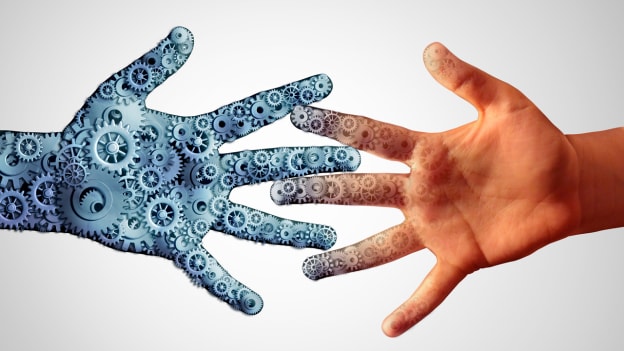Managing multi-dimensional performance for man and machine

The advent of technology has created a heightened interconnectedness in our work lives. A case in point is the blurring boundaries between human and machine workers as they work alongside, and with each other. As the Future of work unravels, new working norms and new skills will continue to emerge. Organizations as a whole are shifting towards a more collaborative, team-based and agile work ethos, and performance management must evolve accordingly.
The impact on work and performance
The traditional performance management system stems from individual-based performance- individual goals and talent reviews that encourage individual contributions. This annual performance review has been touted as cumbersome and misaligned with the true business needs. Periodic pay raises are given to individuals who outperform, while the reality of tomorrow lies in more team-based and cognitive performance parameters. With automation looming large and mundane tasks being taken over by machines, new skills such as problem solving, critical reasoning, collaboration, negotiation, creativity and innovation will be in demand. These are the skills that will drive future business performance. Hence, it is critical to revamp the PMS and Rewards Philosophy to help employees build these modern skills and display the new-age behaviours. Moreover, the PMS design has a direct impact on employee engagement, which is hard to get by in today’s War for Talent.
Only 30 percent of companies rate managers on their people leadership capabilities and only nine percent reward managers based on their ability to lead people.
Clearly, the current reality is far from ideal, and PMS design requires much attention.
A future-ready PMS: Key features
Designing the performance management philosophy and system to reflect the future nature of work, has taken centre-stage in the HR domain. Some of the key features that rewards specialists must keep in mind while designing and conceptualizing the PMS are:
-
Goal clarity: Employees (especially millennials) look for meaning in their work- they wish to know how they matter in the overall scheme of things. Showing employees how their goals originate and feed into the business’ goals will help them understand how they contribute to the company’s success.
-
Coaching outlook: A people-first performance process is essential to espouse the working ethos of collaboration and agility. Progressive companies are cutting out the “stack and rank” approach and replacing it with reflective dialogues to help people “transform” in the desired direction. Frequent check-ins and manager-training are must-haves.
-
Focus on ongoing feedback: Continual feedback is a part and parcel of coaching, hence a modern-day PMS must have inbuilt feedback loops and mechanisms. It is equally important to create a safe and trusting environment for people to converse and connect, so that they can deliver to the new standards. The greatest value comes when performance feedback is connected to the employee and personalized to the learning experiences that will accelerate their contribution and acquisition of new skills*.
-
Fairness and transparency: The perceived fairness of the performance management and rewards process has a direct impact on employee engagement. Perceived inequity can lower employee morale and thereby, low productivity or turnover. HR must encourage open communication about the Rewards philosophy and on how evaluations happen.
-
Integration with talent management: 70 percent of companies felt that there was a need to improve the link between the performance management and other talent decisions*. Closely linking PMS with other HR functions such as total rewards, learning and development, career pathing and growth, succession planning, leadership development, etc., is the key to unlock high performance. HR leaders must set a strategy that combines the business priorities with the desired employee experience****.
-
Data-driven approach: Data and Talent analytics is coming to the rescue for predicting business and performance outcomes. Hardcore data about employee performance, dialogue etc. is making performance management increasingly evidence-based and unambiguous. A data-driven PMS helps build trust with one’s people.
-
People-empathy: Whatever the degree of process-effectiveness or supervisor-competence, the fact is that “you cannot fake caring*”. Adequate manager-support is the baseline for high performing employees. Building empathetic and action-oriented managers that understand and imbibe the Future of Work are a necessary asset. Such people-management must be built from within.
As custodians of people-performance, and therein organizational performance, HR must walk the tight rope between organizational and employee expectations. An increasingly empowered, confident and capable workforce is now demanding a curated and customized employment experience. Organizations, are facing new business realities such as economic uncertainty, political (trade) instability, and talent crunch. HR leaders must move away from the autocratic, stack-and-rank mindset, and see performance management in the new light of aligning employee and team performance with organizational performance through a people-first approach.
HR must deep-dive into the nature of work and skills, to understand what performance means for man and machine. Then, model the system-design on the desired values. HR must carefully select a vendor who understands these nuances, and build the technical functionalities to reflect those values. Whether build or buy, it is important to factor in the voice of the employee and the voice of the business leaders/managers, to ensure business alignment early-on. The PMS must connect with other HR systems to ensure a smooth, integrated employee experience. For example, performance outcomes must feed into the Rewards system, and performance gaps must reflect in the LMS as learning recommendations for employee skill development.
Curating the right performance experience goes beyond mere design and deployment. It is about cultivating the right performance culture. To maintain the multi-dimensional performance ethos, HR leaders must build a culture of learning and performance. They must “walk the talk” by engaging in continuous learning, soliciting ongoing feedback, and communicating openly. This helps people develop trust and belongingness, and makes them go above and beyond in the call of duty.

















